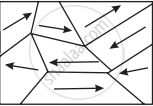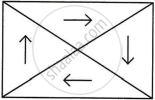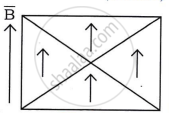Advertisements
Advertisements
प्रश्न
Explain the Domain theory in brief.
उत्तर
Weiss came up with this notion. A ferromagnetic substance, according to this idea, has a vast number of domains. A domain is a tiny region in which all atomic magnetic moments are aligned in the same direction. A domain can be a fraction of a millimetre in size and contain around 1016 - 1017 atoms. Each domain has a magnetic dipole moment as a result.
In the absence of an external magnetic field, the domains are randomly oriented so that the magnetic fields of the domain cancel each other out and the material has no magnetic impact, i.e. the substance has zero resultant magnetic dipole moment, as shown in fig. (a).
 |
 |
| Fig. (a) Unmagnetized substance (i.e.- In absence of magnetic field) |
|
When a weak magnetic field is applied to a ferromagnetic substance, the size of domains with axes parallel to or along the field begins to decrease. grow, while the size of the other domains decreases and the substance magnetises. As illustrated in Fig (b), this process is known as domain growth. When the external field is removed, the material returns to its original place.

Fig. (b) In weak magnetic field (Domain growth)
When a strong magnetic field is given to a ferromagnetic substance, the domain axes turn in the direction of the applied field, and the substance becomes strongly magnetised, as illustrated in Fig. (c). This is known as domain rotation. The domains and magnetic moments do not return to their previous positions when the external field is eliminated.

Fig. (c) In strong magnetic field (Domain rotation)
